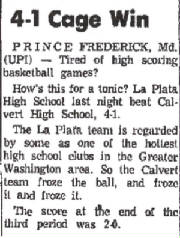
On the evening of Valentine’s Day 1963, Calvert High School lost to La Plata High School by the score of 4-1. The two Southern Maryland schools weren’t playing soccer, baseball or hockey; they were playing basketball. I know, because my brother, then called Bobby Manning, was a starting guard for Calvert. I was known then as Howard Manning, and I graduated from the old Calvert County High School in 1959. I didn’t attend the game, but I found out about it in the strangest of ways.
I was stationed then at Greenville Air Force Base, in Mississippi. The night after the game, I was watching one of the network evening news programs – Cronkite, Huntley-Brinkley, I don’t remember – in the TV lounge at my barracks. Near the end of the broadcast, the announcer said something like this:
“An unusual high school basketball game was played last night in Maryland, between La Plata and Calvert. Calvert froze the ball the whole game and almost won. Their only point came on a foul shot by Bobby Manning. And that’s the way it is…”
More than four decades after the event my brother now calls “The Game,” I decided that I wanted to find out what really happened. But where was I going to start? Bobby (called Bob now) was not a good source, most of the details having been purged from his memory. So I tried looking for old newspaper articles about it. The Calvert County Library tried to help but couldn’t find any, so I checked out NewspaperARCHIVE.com, an online paid subscription service with over a billion articles on file. Surprisingly, I found more than a dozen about it, all various versions of a short UPI item that ended up in a number of newspapers across the country.
One of them mentioned the Calvert coach as Gordon Wright, who I remembered as a young teacher when I was a student. So I looked up his name in the Internet white pages for Maryland, knowing full well that there was little chance I would locate him. After all, he could be anywhere, if he was even still around. I found five listings for that name and called the first one. It was him.
He was stunned and excited, and eager to tell me all about the game. I interviewed him, and within two weeks, I had tracked down and interviewed the other Calvert Coach, Tim Carney, and two of the La Plata players, Dale Cornette and Larry Ringer. I also interviewed brother Bob. In the following paragraphs, you will find all you’ll ever need to know about one crazy basketball game.
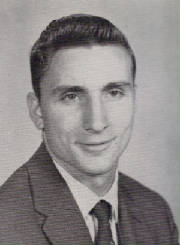
Gordon Wright
Gordon Wright grew up in Garrett County, Maryland, in the rural western part of the state. He worked in steel mills and automobile factories in Ohio and Baltimore in the summer to help pay for college. After attending Potomac State College, in West Virginia, he graduated from West Virginia University, where he later got his master’s degree. In 1958, he was hired for his first teaching job, at Calvert County High School.
“At that time, the schools were segregated,” Wright remembers. “There was Brooks High School, the black school, and Calvert. I got a job teaching math, science and social studies. I met the physical education teacher and coach, Don Merriman, and he and I became good friends. Don had come out of Glenville State College in West Virginia, and had been at Calvert about two years. I told the administration that I was trained in physical education and science, and that I did not plan to be back the following year unless they gave me a position in physical education. So they put me in charge of physical education for the seventh and eighth grades. I started helping Don with the athletic teams, and since I played soccer in high school, I became the soccer coach.”
“I helped Don with the coaching for two years, and then in the fall of 1961, he got a job at Gwynn Park High School, in Prince George’s County (Maryland). So I took over the basketball team, but there was no pay for coaching. When the new Calvert High School opened in 1962, I had a family by then, so I applied for a job in Prince George’s County, where the pay was much better, and it was within driving distance of my home in Dares Beach.”
“In the meantime, I met Tim Carney, also from Glenville State, who had started teaching in the middle school, which was in the old Calvert County High School building. I asked him to help me coach. He knew a lot more about basketball than I did. They were still building the gymnasium. It was not going to be completed until the second half of the year, so we had to schedule all our games away from home at the beginning of the season. I was teaching physical education classes in a barn out in back.”
“Calvert was a rural county, and a lot of the kids never came out for the team until they were 16 years old and could drive a car, because that was the only way to get home from games and practice. Therefore, Calvert’s teams were not very successful. In fact, when Don was there, we had about five wins each year, and I had a similar record my first year. But for this season, we had a pretty good team.”
Wright still has vivid memories of the game, and most of what he told me is confirmed by the newspaper articles, including one he sent me from the Washington Star. Wright continues:
“Ed Lakes, the coach at La Plata, had come out of West Virginia. There was rumor that he had won a high school state championship there. In an earlier game at La Plata, they had beaten us badly, 79-53. When we played them at Calvert, La Plata already had 15 victories. Tim Carney came up with the strategy, and I figured we had nothing to lose by trying. Tim said, ‘La Plata plays a zone defense. Let’s hold the ball and make them come out and play us. If they do that, we’ll have an opening to go in.'”
“In those days, there was no shot clock, so you could hold the ball. But you couldn’t just stand there with the ball, you had to make an attempt to go in toward the foul line every 15 seconds. So I told my two guards, Bobby Manning and Johnny Mattera, ‘Stand out there, dribble in toward the foul line every so often, but don’t try to take the ball all the way in as long as they are back in that zone.'”
“So La Plata got the tip-off – every quarter started with a jump ball in those days – and they went down and scored a basket. We came back and held the ball. Immediately, Lakes yells to his players, ‘Get back. Don’t go out after them.’ He saw what we wanted to do, so we told the boys, ‘Just keep it up, you’re only behind by two points.’ At the end of the quarter, we hadn’t taken a shot, and La Plata hadn’t touched the ball again. La Plata got the tip in the second quarter, but they missed a shot. We got the ball back and did the same thing, and the half ended like that.”
“At halftime, we reminded the boys, ‘If they come out to get you in man-to-man coverage, then try to score, but don’t be too anxious. If we keep this up, we’ll still be in the game all the way to the end.’ The players were doing just what we wanted them to do, and they were doing it well. They realized that they had lost badly to La Plata, and they seemed to be with us on the strategy.”
“La Plata got the tip in the third quarter and scored right away, so it was 4-0. And then we held the ball the rest of the quarter. In the fourth quarter, we lost the tip again, but La Plata missed a shot, and we got the ball back. Late in the game, Bobby made a little push in and got fouled. Lakes yelled at his team, ‘Don’t do that, stay back.’ In those days, there was no such thing as the one-and-one, so Bobby got only one shot, and he made it. We put some pressure on, La Plata missed a shot, and we came back down.”
I wondered out loud why Wright didn’t call time-out.
“Back then, the coach couldn’t call a timeout. The boys on the floor had to do that. There was a lot of noise from the fans. It went down to the very end of the game, and we were yelling to the boys to take it in and shoot it. I think they were afraid of making a mistake, so they just kept passing it back and forth. They weren’t paying any attention to the clock, and it ran out. So Bobby’s foul shot was the only shot we took in the game.”
I asked why Calvert didn’t at least toss up a 20-footer at the end of each quarter.
“In hindsight, that’s what we should have done. But La Plata put on a little token pressure right toward the end of each quarter, so it wasn’t as easy as you think. You have to remember that you’re dealing with young boys that were not that experienced. You also have to understand that we didn’t anticipate this type of game. I think Lakes should take credit for the low score, because he pulled his team back and refused to challenge us. But we had a good season. In fact, we won the rest of our home games.”
Tim Carney
Though Wright didn’t know the whereabouts of Carney, I found him living, not surprisingly, in Glenville, West Virginia. His recollections are similar to Wright’s.
“I came to Calvert in the fall of 1962. I taught physical education and language arts and coached basketball at the middle school. I remember a game against Brooks Middle School. The schools were still segregated then, and the only people that were allowed at that game were the coaches, players and cheerleaders. But there was no trouble. Then a coaching job came up at Calvert High School, so I taught at the middle school and coached at the high school.
“The game plan was to see if we could bring La Plata out of their zone. But Lakes was kind of a stubborn guy, so if he didn’t let them come out, we planned to hold the ball and try to take a shot at the end of each quarter. They took the lead right away, but at 2-0, we didn’t feel like we were out of the game. So we basically just passed it around the perimeter. It was just one of those crazy things. We never thought it would end that way.”
Once again, I asked the obvious question: “Why didn’t you take a shot?”
“It was always our goal. If we had the ball, we would take a shot at the end of each quarter. Why we didn’t get a shot off, I don’t remember. One of our best players was Jimmy Tidwell, and his father Jim, who was the football coach, was not very happy after the game. He complained that it was an awful idea to hold the ball.”
In the fall of 1965, Carney left Calvert for Gwynn Park, where he became the basketball coach. Right away he was reminded of “The Game.”
“I’ll never forget the guy who was the athletic director of Prince George’s County. In a pre-season gathering of the basketball coaches, he made light of the game and said that he didn’t want to see that type of coaching in his schools. And there I am sitting in the audience. Obviously, I wasn’t going to raise my hand and tell him I was the guy who did it.”
Carney said that the game hardly ever came up in conversation, until many years later at a college golf tournament.
“I was coaching the golf team at Glenville State. James Madison University would hold a spring tournament every year, and they often brought in some Division One teams. That year, the University of Maryland and the Naval Academy came. I was standing in the pro shop, and this guy comes up and says, ‘You’re Tim Carney, aren’t you? You’re the guy who was at Calvert County when they held the ball against La Plata.’ I said, ‘I had almost forgotten about that.’ And he said, ‘Well, I haven’t forgotten. I played on that La Plata team.’ It was Larry Ringer, and he was the golf coach at the Naval Academy. About a year later, I went up to Annapolis and visited him.”
Interviews With Players
Larry Ringer
Ringer had come up the ranks at La Plata with Dale Cornette, and on the 1963 team, he was the starting shooting guard. I found him living in West Virginia also. He was happy to talk about the game.
“We were expecting Calvert to come out running and gunning very quickly. So it was a shock to everybody that it was a stall. Coach Lakes told us to just sit back and let them make the first move. We had a height advantage, and we could run with anybody, so we just waited for Calvert to make a mistake. When Tommy Jameson made the first shot, I got the assist. The longer the game went on, the more pressure was on both teams. Calvert knew they were going to have to make a basket, and we were afraid of making a mistake. We were very focused on playing good defense, which is one thing that Coach Lakes always stressed.”
“When we got home, nobody believed us when we told them the score. They said things like: ‘Yeah, right. So what really happened?’ ‘How bad did you beat them?’ or ‘Did you guys get beat, and that’s why you won’t tell us the truth?’ Later that night, I remember sitting in front of the TV at home, and they gave the score on the local news, and my mother says, ‘Okay, I guess you were telling the truth.'”
“When Dale and I went to Charles County Community College (also in La Plata), Bill Close, who had coached at nearby Lackey High School, became the coach for us. One day, we took a long bus ride up to Cumberland to play Allegany Community College. Bill had heard about the game, and he talked to us about it for over an hour.”
Dale Cornette
Ringer’s teammate, Ivan (Dale) Cornette, was the point guard. He made the other basket for La Plata. In his scrapbook, he has an article about the game, which includes the box score. But he doesn’t remember any of the Calvert players.
“Back in those days, we really didn’t know the players on the other teams. It was a very rural area. There were no summer leagues, nothing like that. But I do remember the new Calvert gym. The floor was right up against a cinder block wall on one side. You only had about two feet to the wall. They had bleachers on one side, and then an upper deck with bleachers. They’ve changed it a lot since then.”
After Manning hit the foul shot and Calvert got the ball back, Dale got worried.
“We were up by only three points. I was afraid that we might foul them when they made a shot, and they could tie the game with a 3-point play. I remember telling that to Jimmy Cox, our best scorer. I yelled, ‘We can’t foul them.'”
But when the game was over, Cornette didn’t recall it being a big deal.
“It was just something that happened. It was like a fluke. We knew we were going to win either way, by three points or 20 points. Coach Lakes just said, ‘Get dressed and let’s go home.’ We hadn’t exactly worked up a sweat, because we just stood there most of the time and watched them. We didn’t even take showers; we just changed into our clothes and got on the bus. Years later, I talked to my teenage son about the game, and when I told him the score, he looked at me like I was nuts, shrugged his shoulders and walked away.”
Bobby Manning
By the time my brother was playing varsity sports, I was off at college, and then in the Air Force, so I don’t think I ever saw him play basketball at school. When we sat down at his home recently, I think it was the first time we had ever talked about the subject.
“I think Calvert played only four sports: football, basketball, baseball and track. I played them all. I wasn’t that strong in basketball. I was just naturally athletic. Getting to school was easy, because I rode the bus from our house in Solomons. But getting home was a big problem, because I had to stay after school every day for practice. Sometimes I could get a ride with someone, but I had to hitchhike a lot, and it was 20 miles. Fortunately, Calvert County was a small place, so people would recognize me. I often wonder what our parents thought about it.”
I had been telling him some of the details I was getting from the other interviews, and that seemed to jog his memory a bit.
“La Plata was a powerhouse team. We went into the game with the idea that we were going to freeze the ball, but I don’t know how much we worked on it in practice. I remember in those days watching college basketball on TV, and teams that were ahead would often go into a stall at the end of a game.”
“The thing that stands out in my mind is that our strategy was successful. But the ultimate objective is to win the game, and we didn’t win. But we didn’t get beat by 50 points. I don’t think we had a good plan at the end of the game. It was close, and a basket or two could have won it for us. I remember going in with the ball and making a head fake, and the guy that was guarding me went for the fake and landed on me. I made the foul shot, but the last time we had the ball, we just ran the clock out.”
“It was kind of bizarre. It seems like the coach could have prepared us better. He could have yelled at us to call timeout or take a shot. After the first quarter was over, he should have told us to put up a shot in the last 15 seconds of the quarter, or something like that. The game went by really fast, because there were no dead balls. I remember some of the crowd yelling at us to shoot. It seems weird now, but we were just following the coach’s instructions.”
Successful careers for all
All those interviewed for this article went on to have successful careers.

Robert (Bobby) Manning graduated from Washington College (in Maryland), served in the Coast Guard, and earned his master’s and doctorate degrees at Michigan State. For more than 30 years, he has been on the faculty at the University of Vermont, and is currently Professor of the Recreation Management Program in the School of Natural Resources. His wife of more than 40 years is the former Martha Sansbury, who was a pom-pom girl for Calvert the night he scored the famous one point.

Larry Ringer, a longtime member of the Professional Golfers Association, lived in La Plata for number of years before settling in West Virginia, only about a half-hour from Myersville, Maryland, where he is director of golf instruction at the Musket Ridge Golf Club.
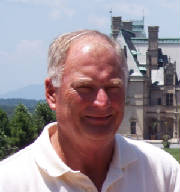
Dale Cornette, who has lived in the La Plata area all his life, graduated from Appalachian State University and started teaching in 1968. After a brief coaching stint at Lackey, he got a job at Thomas Stone High School, in nearby Waldorf, where he was a coach for several years, and a teacher until his retirement about 10 years ago. In 1972, his basketball team won the Class B state championship. He still teaches part time at College of Southern Maryland, in La Plata.
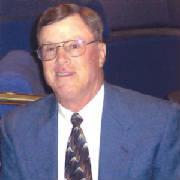
Tim Carney coached the Gwynn Park basketball team to a state championship in 1968. From there, he went to Glenville State College and stayed 34 years, where he was an assistant men’s coach for 11 years, and then head coach in the women’s program for nine years. He was also the head golf coach for 24 years. He taught physical education, and was athletic director for two years. He retired in 2001.
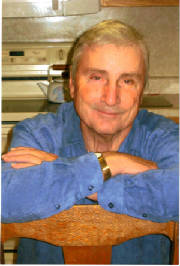
Gordon Wright never coached again after the 1963 season. He retired 20 years ago after 31 years of teaching, 25 of those years in Prince George’s County, where his salary in his first year went from $4,500 at Calvert to $7,350. An avid hunter and fisherman, he is back in Garrett County now. He and his wife remain close friends with Don Merriman, visiting him occasionally in Florida. Three of the Wright children still live in Calvert County.
Winfred (Ed) Lakes, the La Plata coach, deserves mention here, though I was not able to interview him or obtain a photo. He passed away in 2007, at the age 82. According to his obituary, he was a teacher, coach, high school vice principal, and supervisor of physical education and health in the Charles County school system. In 1984, he was inducted into the Maryland State Athletic Directors Association Hall of Fame. At his funeral, Dale Cornette was one of the pallbearers.
One for the records?
Was the game’s total of five points some kind of a record? I asked the National Basketball Hall of Fame, and they referred me to the National Federation of State High School Associations. I got the answer in less than 24 hours. Among official high school basketball games, there have been three 1-0 games, and five 2-0 games, one of which went into overtime. There was also a 5-0 overtime game. I found articles about seven of them, and in each one, the winning team held the ball the rest of the game once they had taken the lead. So Calvert/La Plata ties for ninth lowest, but it was perhaps the only game where the team that was behind held the ball.
A parting shot
My brother had one more story for me, which seems to wrap up the game and put a bow around it.
“In homeroom, every day after a sporting event, someone in the office would get on the loudspeaker and announce the score and a few details about the game. When they announced our game, they tried to make a joke about it. They said that we lost 4-1, and that I was the high scorer with one point.”
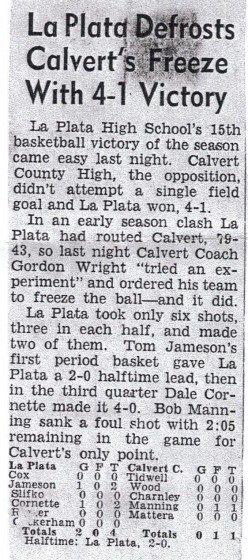
Postscript
Several months after publishing this story, I received this surprising email from Alan W. King, who added some juicy, first-hand details about the game. He gave me permission to include a slightly edited version of that email, which I have posted below. Thanks Alan!
“A few months ago, my brother, David King, and I were talking on the phone and he told me about an article you had written, where La Plata beat Calvert 4-1, in a basketball game. He asked me, ‘Do you remember that game?’ I told him, ‘I sure do. I spent the entire time sitting on the bench (for Calvert).’ I was the only freshman to make the varsity team that year. We had dinner together at his house last weekend and he had saved the article for me, which I read with great interest. Since you indicated in the article that you wanted to find out what really happened, I thought I would add my memories of the event.”
“You quoted Coach Wright, who said that Calvert had lost to La Plata on their home court by a score of 79-53. I don’t recall the exact score, but it was more like 83-32, a real butt whipping. There were two main players on the La Plata team that were not mentioned, but they were the primary reason Coach Carney came up with the stall strategy. I don’t remember their first names, but their last names were Cockerham and Slifko. They were 6′ 7″ and 6′ 8” – the original “twin towers” during our day. They both received college basketball scholarships. I think our tallest guy that season was about 6′ 2″, so Larry Ringer’s statement that La Plata had a height advantage was a gross understatement.”
“There is also a discrepancy in Ringer’s and Dale Cornette’s account of the scoring, as I recall it. The last basket for them was also scored by Tommy Jamison. When we had the ball, Johnny Mattera, who was playing the point, would pass the ball to Bobby (Manning), who would take it to the foul line, then pass it back to Mattera, who would pass it to Jimmy Tidwell, who would take it to the foul line and then pass it back to Mattera. Jamison’s basket came about because this pattern got repeated so many times at a monotonous pace, that it was easy for Jamison to time a steal, which he did, and dribbled the length of the court for an uncontested layup.”
“As I recall it, that was the only second half score, and Jamison also had their only first half score, which would allow for Ringer’s comment that he got the assist, but contradicts Cornette’s account. Perhaps I just remember the steal and that Jamison may have passed it to Cornette, who scored. (Note: the box score confirms that Cornette scored the basket).”
“In any case, neither one of their baskets came as a result of winning the tip-off. We actually got one of the four tip-offs when either Mattera or Tidwell stepped in front of the player intended to receive it. As for Manning’s score, he actually was driving toward the basket and got off a shot. We were hoping that it would be a two-shot foul, but the referee ruled the foul occurred prior to the shot, so it was only a one-shot foul. There actually was a one-and-one foul in those days, but it only occurred after the opposing team reached six fouls which, needless to say, wasn’t the case.”
“Your article brought back a number of memories from 46 years ago. I’ve told this story a number of times and received the same ‘Yeah, right!’ reaction that most people had when hearing of the score. It was one crazy basketball game.